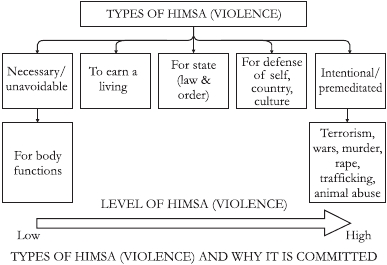Himsa can be classified into several broad categories, in increasing order of severity and harm and also for binding of karmas and thus increasing the karmic load:

Anivaarya/swaroopi is unavoidable himsa. This refers to himsa that occurs when living beings are doing such basic things as breathing, speaking, eating, walking, and sleeping. Here, the person should observe all the care to avoid himsa and to reduce it as much as humanly or otherwise possible. This kind of himsa is the least severe in terms of inflow and binding of karmas. Generally, Jain monks adhere to the observance of this kind of ahimsa.
Aarambhi/uddyogi is himsa that is ethical for the purposes of earning a living. Every householder has to support life by earning a living and producing food, clothing and shelter. Here, one must look at all the alternatives and at doing the least possible himsa. One must question whether something is a want or a need. One must determine how to make a living with ethics, with morality, with the least harm to the environment and to the fellow beings (humans and non- humans). Also, one must limit and exercise control over one’s needs and wants with aprigraha (fewer attachments and accumulations). Obviously, the level of himsa committed here is more than that of unavoidable himsa.
Rajkeeya is himsa done in performing duties to and for the state or the country. This is himsa that is mandated by the society and the government to maintain law and order in the society. It includes the sentencing of convicted criminals by the courts and by police and other law-maintaining authorities. Here, the individual exercising himsa must take precaution to minimize its level. He should not do himsa to others with a motive of a personal vendetta, revenge, prejudice, hate, a show of power, greed, or for personal benefits and gains. The practitioner is obeying the just laws of the land. However, unjust laws should be resisted and opposed. One must make sure that innocents are not punished or inflicted with pain. The intensity of this himsa is greater than the previous two.
Virodhi himsa is himsa done in defense and protection. It could be in defense of the culture, community or country, or of innocent people. This kind of himsa generally refers to serving in the military. The practitioner should not hate the enemy or be motivated by self-interest, personal gain, or retribution. In other words, he commits himsa without any desire to harm the opponent. He should observe all precautions to minimize the level of himsa while still striving to achieve the goals. This himsa is acceptable but the level and intensity of himsa is much higher than in the types of himsa mentioned above.
Sankalpi himsa is pre-meditated himsa. This is an action planned and executed with full force of all the senses and the mind, speech, and body. Sankalpi himsa includes all deeds involving intentional, pre-meditated violence.
For example a murderer clearly sets out to end the life of his victim, hence he commits sankalpi himsa. Other examples would include incidents of terrorism such as the 9/11 attacks and the 1995 Oklahoma City bombing.
This is the severest kind and highest level of himsa, since all the faculties of the practitioner (mental, verbal, and physical) are fully engaged.
The doer of this type of himsa binds to himself anootaan- bandhi karmas, which cannot easily be washed away or obliterated (a helpful metaphor is to imaging marking a line in stone or in steel). These kinds of karmas cannot be shed or destroyed by the doer without his suffering the results. Such himsa must not be condoned under any circumstances and must be avoided at all costs.
 Dr. Sulekh Chand Jain
Dr. Sulekh Chand Jain
